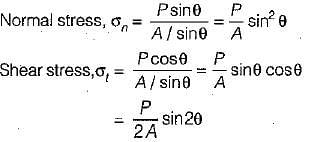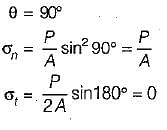Mechanical Engineering Exam > Mechanical Engineering Questions > A bar of square cross - section has b ee n su...
Start Learning for Free
A bar of square cross - section has b ee n subjected to an axial tensile load. A plane normal to the axis of loading will have
- a)maximum shear stress and minimum normal stress
- b)maximum shear stress as well as maximum normal stress
- c)maximum normal stress and zero shear stress
- d)minimum normal stress and zero shear stress
Correct answer is option 'C'. Can you explain this answer?
| FREE This question is part of | Download PDF Attempt this Test |
Verified Answer
A bar of square cross - section has b ee n subjected to an axial tensi...



For the plane normal to the axis of loading,

Most Upvoted Answer
A bar of square cross - section has b ee n subjected to an axial tensi...
Explanation:
When a bar of square cross-section is subjected to an axial tensile load, the stress distribution within the bar can be analyzed to determine the maximum normal stress and the shear stress.
Normal Stress:
Normal stress is the stress that acts perpendicular to the cross-sectional area of the bar. In this case, when the bar is subjected to an axial tensile load, the normal stress will be maximum on a plane that is perpendicular to the axis of loading. This is because the axial tensile load is directly causing the elongation of the bar in the axial direction, resulting in maximum stress on a plane perpendicular to this direction. Therefore, the maximum normal stress will occur on a plane normal to the axis of loading.
Shear Stress:
Shear stress is the stress that acts parallel to the cross-sectional area of the bar. In this case, when the bar is subjected to an axial tensile load, there will be no shear stress present on any plane normal to the axis of loading. This is because the axial tensile load is causing the bar to elongate uniformly in the axial direction, without any relative displacement between different layers of the bar. Therefore, there will be zero shear stress on a plane normal to the axis of loading.
Conclusion:
Based on the analysis of stress distribution within the bar, it can be concluded that a plane normal to the axis of loading will have maximum normal stress and zero shear stress. This aligns with option 'C' as the correct answer.
When a bar of square cross-section is subjected to an axial tensile load, the stress distribution within the bar can be analyzed to determine the maximum normal stress and the shear stress.
Normal Stress:
Normal stress is the stress that acts perpendicular to the cross-sectional area of the bar. In this case, when the bar is subjected to an axial tensile load, the normal stress will be maximum on a plane that is perpendicular to the axis of loading. This is because the axial tensile load is directly causing the elongation of the bar in the axial direction, resulting in maximum stress on a plane perpendicular to this direction. Therefore, the maximum normal stress will occur on a plane normal to the axis of loading.
Shear Stress:
Shear stress is the stress that acts parallel to the cross-sectional area of the bar. In this case, when the bar is subjected to an axial tensile load, there will be no shear stress present on any plane normal to the axis of loading. This is because the axial tensile load is causing the bar to elongate uniformly in the axial direction, without any relative displacement between different layers of the bar. Therefore, there will be zero shear stress on a plane normal to the axis of loading.
Conclusion:
Based on the analysis of stress distribution within the bar, it can be concluded that a plane normal to the axis of loading will have maximum normal stress and zero shear stress. This aligns with option 'C' as the correct answer.
Free Test
FREE
| Start Free Test |
Community Answer
A bar of square cross - section has b ee n subjected to an axial tensi...
Because the planes are complementary planes
Attention Mechanical Engineering Students!
To make sure you are not studying endlessly, EduRev has designed Mechanical Engineering study material, with Structured Courses, Videos, & Test Series. Plus get personalized analysis, doubt solving and improvement plans to achieve a great score in Mechanical Engineering.

|
Explore Courses for Mechanical Engineering exam
|

|
Similar Mechanical Engineering Doubts
A bar of square cross - section has b ee n subjected to an axial tensile load. A plane normal to the axis of loading will havea)maximum shear stress and minimum normal stressb)maximum shear stress as well as maximum normal stressc)maximum normal stress and zero shear stressd)minimum normal stress and zero shear stressCorrect answer is option 'C'. Can you explain this answer?
Question Description
A bar of square cross - section has b ee n subjected to an axial tensile load. A plane normal to the axis of loading will havea)maximum shear stress and minimum normal stressb)maximum shear stress as well as maximum normal stressc)maximum normal stress and zero shear stressd)minimum normal stress and zero shear stressCorrect answer is option 'C'. Can you explain this answer? for Mechanical Engineering 2024 is part of Mechanical Engineering preparation. The Question and answers have been prepared according to the Mechanical Engineering exam syllabus. Information about A bar of square cross - section has b ee n subjected to an axial tensile load. A plane normal to the axis of loading will havea)maximum shear stress and minimum normal stressb)maximum shear stress as well as maximum normal stressc)maximum normal stress and zero shear stressd)minimum normal stress and zero shear stressCorrect answer is option 'C'. Can you explain this answer? covers all topics & solutions for Mechanical Engineering 2024 Exam. Find important definitions, questions, meanings, examples, exercises and tests below for A bar of square cross - section has b ee n subjected to an axial tensile load. A plane normal to the axis of loading will havea)maximum shear stress and minimum normal stressb)maximum shear stress as well as maximum normal stressc)maximum normal stress and zero shear stressd)minimum normal stress and zero shear stressCorrect answer is option 'C'. Can you explain this answer?.
A bar of square cross - section has b ee n subjected to an axial tensile load. A plane normal to the axis of loading will havea)maximum shear stress and minimum normal stressb)maximum shear stress as well as maximum normal stressc)maximum normal stress and zero shear stressd)minimum normal stress and zero shear stressCorrect answer is option 'C'. Can you explain this answer? for Mechanical Engineering 2024 is part of Mechanical Engineering preparation. The Question and answers have been prepared according to the Mechanical Engineering exam syllabus. Information about A bar of square cross - section has b ee n subjected to an axial tensile load. A plane normal to the axis of loading will havea)maximum shear stress and minimum normal stressb)maximum shear stress as well as maximum normal stressc)maximum normal stress and zero shear stressd)minimum normal stress and zero shear stressCorrect answer is option 'C'. Can you explain this answer? covers all topics & solutions for Mechanical Engineering 2024 Exam. Find important definitions, questions, meanings, examples, exercises and tests below for A bar of square cross - section has b ee n subjected to an axial tensile load. A plane normal to the axis of loading will havea)maximum shear stress and minimum normal stressb)maximum shear stress as well as maximum normal stressc)maximum normal stress and zero shear stressd)minimum normal stress and zero shear stressCorrect answer is option 'C'. Can you explain this answer?.
Solutions for A bar of square cross - section has b ee n subjected to an axial tensile load. A plane normal to the axis of loading will havea)maximum shear stress and minimum normal stressb)maximum shear stress as well as maximum normal stressc)maximum normal stress and zero shear stressd)minimum normal stress and zero shear stressCorrect answer is option 'C'. Can you explain this answer? in English & in Hindi are available as part of our courses for Mechanical Engineering.
Download more important topics, notes, lectures and mock test series for Mechanical Engineering Exam by signing up for free.
Here you can find the meaning of A bar of square cross - section has b ee n subjected to an axial tensile load. A plane normal to the axis of loading will havea)maximum shear stress and minimum normal stressb)maximum shear stress as well as maximum normal stressc)maximum normal stress and zero shear stressd)minimum normal stress and zero shear stressCorrect answer is option 'C'. Can you explain this answer? defined & explained in the simplest way possible. Besides giving the explanation of
A bar of square cross - section has b ee n subjected to an axial tensile load. A plane normal to the axis of loading will havea)maximum shear stress and minimum normal stressb)maximum shear stress as well as maximum normal stressc)maximum normal stress and zero shear stressd)minimum normal stress and zero shear stressCorrect answer is option 'C'. Can you explain this answer?, a detailed solution for A bar of square cross - section has b ee n subjected to an axial tensile load. A plane normal to the axis of loading will havea)maximum shear stress and minimum normal stressb)maximum shear stress as well as maximum normal stressc)maximum normal stress and zero shear stressd)minimum normal stress and zero shear stressCorrect answer is option 'C'. Can you explain this answer? has been provided alongside types of A bar of square cross - section has b ee n subjected to an axial tensile load. A plane normal to the axis of loading will havea)maximum shear stress and minimum normal stressb)maximum shear stress as well as maximum normal stressc)maximum normal stress and zero shear stressd)minimum normal stress and zero shear stressCorrect answer is option 'C'. Can you explain this answer? theory, EduRev gives you an
ample number of questions to practice A bar of square cross - section has b ee n subjected to an axial tensile load. A plane normal to the axis of loading will havea)maximum shear stress and minimum normal stressb)maximum shear stress as well as maximum normal stressc)maximum normal stress and zero shear stressd)minimum normal stress and zero shear stressCorrect answer is option 'C'. Can you explain this answer? tests, examples and also practice Mechanical Engineering tests.

|
Explore Courses for Mechanical Engineering exam
|

|
Suggested Free Tests
Signup for Free!
Signup to see your scores go up within 7 days! Learn & Practice with 1000+ FREE Notes, Videos & Tests.
























